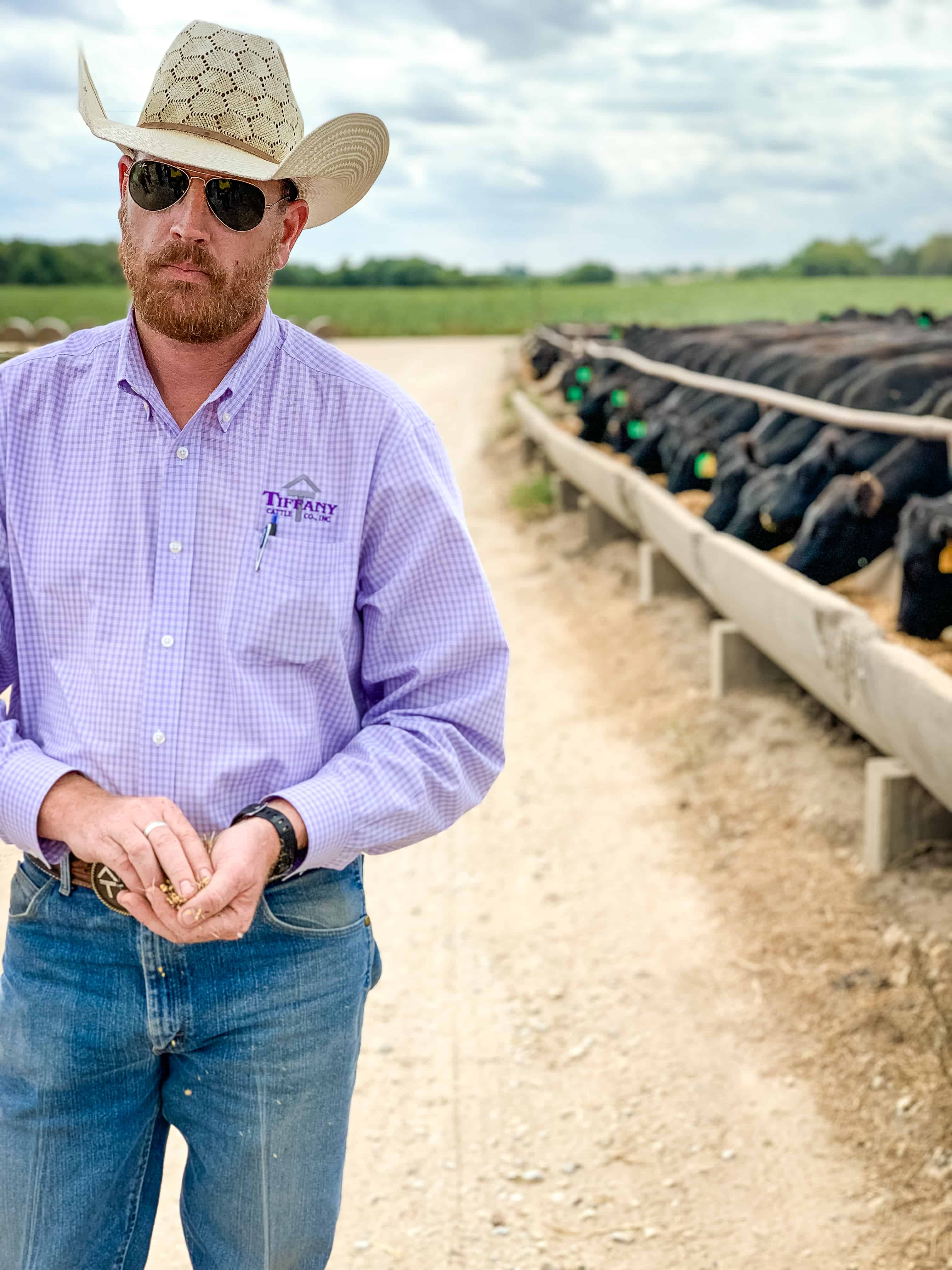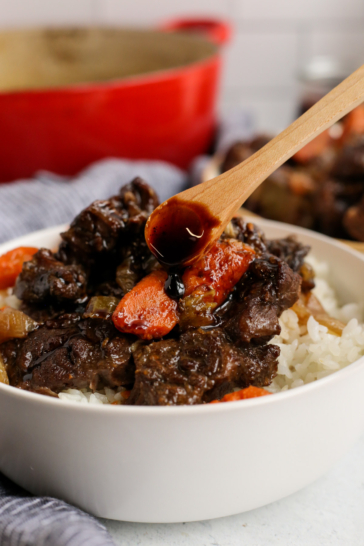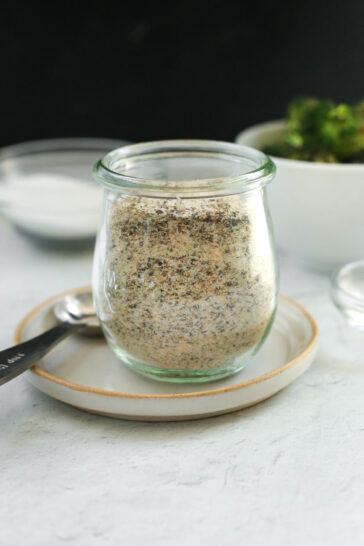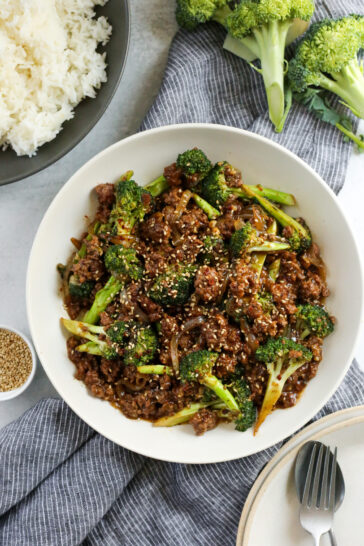Have you ever wondered, “Where does food come from?” If you’re like me, you don’t get many chances to see behind-the-scenes of Kansas agriculture. That’s why I’m excited to share what I learned on the Farm Food Tour!
Disclosure: This post was written in partnership with Kansas Farm Bureau and Kansas Soybean Commission. I was compensated for my time and travel. Thank you for supporting the partners that support Street Smart Nutrition!

I’ve always been a naturally curious person. As a young child my parents were constantly finding new books for me to read because I would tear through them so quickly and ask for something new to learn! So it seemed fitting for me to gravitate towards my current job as a dietitian. It allows me to connect two of my favorite things: learning and food!
Recently, I was invited to attend the 2019 #FarmFoodTour, hosted by the wonderful teams at Kansas Farm Bureau and Kansas Soybean Commission. For three days in September, I toured farms big and small throughout east-central Kansas. Now I’ve finally gotten around to sharing what I saw with all of you!
This isn’t the first time I got to learn more about where food comes from! Check out my recap of What I Learned On a Pig Farm.

Kansas Agriculture
The goal of these farm tours is never to claim that these small glimpses into life on a farm is representative of agriculture as a whole. Kansas agriculture is unique in many ways, but so is food production in any other state or region. Our agenda was jam-packed but it allowed us to see a wider variety of farming technology and practices than if we spent lots of time on a single farm.
Our first stop was Juniper Hill Farms near Lawrence, Kansas. Scotty Thellman is a first-generation farmer who grows vegetables, melons, hay, and soybeans. I found his farm and viewpoints on farming especially interesting because he grows both organic and conventional products. He shared some of the plans for expanding the farm and diversifying where and how they sell what they grow, and it boiled down to the prices and demand.

It was fascinating to hear about how farms of any size can struggle to remain financially stable with fluctuations in price and demand. While many consumers say they want organic produce, their shopping habits don’t always reflect that. Before hearing Scotty explain the planning process, I didn’t realize how much guesswork and risk is involved in trying to predict future food trends.
Investing in hoop houses like the ones pictured here can be an enormous expense. It might mean they prioritize that over things they used to focus on, like row crops or hay. However, the payoff might be there because they can extend their growing season, control pests more effectively, or experiment with new crops that haven’t been grown here before.

After hearing from Scotty and touring the updated packaging line inside one of his converted barns, we traveled to our next stop on the Farm Food Tour: The Good Farm in Olsburg, Kansas. Craig and Amy Good raise heritage hog breeds (Durocs and Gloucestershire Old Spots), plus soybeans, corn, and Angus cattle.

They welcomed us to an amazing lunch on their farm before taking us out to meet the pigs. Although lots of pork is raised indoors, the Goods have multiple pens and hoop houses for their pigs to spend the majority of their time outdoors. Despite the difference in the environment, these pigs receive the same care and attention to detail. The Goods work with several livestock nutritionists to custom-tailor the feed rations for the pigs as they grow through different stages of life.

We spent the evening learning about Kansas viticulture – that’s right, there is a growing interest in winemaking in Kansas! After enjoying an evening in Manhattan, Kansas, we headed out early the next morning to visit a fiber farm.

We don’t typically think of fiber (wool) as an agriculture product. I definitely did not! But it was insightful to learn about how sheep and goats are used to produce the wool that eventually gets cleaned, milled, and woven into the textiles and fabrics we take for granted every day.
After learning about the process of taking wool from sheep (or goat) to wool or yarn, we spent some time in the barnyard meeting some of the animals who will eventually be sheared for their wool. It was a little like an adult version of a petting zoo, complete with handfuls of feed to get their attention.

The second stop was one of the most interesting of the entire tour, and one I had been anticipating since we first laid eyes on the agenda. Tiffany Cattle Company is a cattle feed yard owned and operated by two brothers, Shawn and Shane.
When I thought of a feed yard, I really didn’t know what to think. I wasn’t sure how I felt about the idea of cattle in pens, confined to a small area, or being in such close proximity to each other. I wondered about things like the environmental impact of producing beef in this manner, waste management, noise, and odors. I also wanted to know more about how the animals are cared for, tracked, and managed in such large numbers.
But Shane answered all of those questions and more as we toured the feed yard and it was incredibly helpful to be able to see it with my own two eyes and process what I was learning.

In light of several papers, documentaries, and articles that have recently come out, there has been a greatly increased interest in plant-based eating. There is interest due to concerns about environmental and planetary health, as well as personal health and nutrition. However, based on what I’ve learned from visiting farms of all kinds is that not all land is a good place to grow high-quality food for human consumption. Whether it’s because of the climate, the soil, or any number of other factors, some land (such as the Flint Hills of Kansas) are better suited for grazing livestock.
Feed yards can serve a role in this. Although it may seem strange to think about, whenever a process is more efficient it can become less wasteful. While eating animals is a deeply personal choice and I never intend to influence someone on what to think, I feel it’s important to point out that it’s not as simple as saying, “Eating meat is bad for the environment.” It’s a very complex issue.
Although I still don’t have all the answers to my questions, I now have new resources to reach out to when I want to learn more about raising beef. Seeing for myself also changed my impression of feed yards. It didn’t have a strong odor at all and it was very quiet. Quiet animals are calm animals, and none of the cattle I saw seemed distressed. There were hardly any flies, thanks in part to some of their unique strategies for controlling insects (like releasing wasps to curb the fly population).

Since we had just been discussing feed and animal nutrition, it made sense that our next stop was a family farm that grows soybeans, grain sorghum, wheat, and field corn. Kim Balwin of Baldwin Farms joined us for the duration of the Farm Food Tour, but our last stop of the day brought her back home to share what her family does for Kansas agriculture.

Since we visited in September, harvest was in full swing and we were able to see the team in action. Field corn, like what you see pictured here, is very different from the sweet corn you’d find at the farmers market or the popcorn you enjoy for movie night. This type of corn has a much higher starch content and is harvested after it’s been dried down. After that, it’s final destination is livestock feed or ethanol.

The Farm Food Tour was also my first chance to see sorghum growing in a field. It’s one of my favorite ingredients to cook with because of its chewy, dense texture. It’s tasty and filling and I’ve made some great recipes with it but had never seen it outside of a kitchen before. Sorghum (also called milo) can end up being used to feed both humans and animals, and as a very drought-resistant crop it’s a good fit for drier regions in Kansas.
Looking for some sorghum recipes? Try these Gluten Free Chocolate Chip Cookies or my Sweet Potato Sorghum Salad!

After another enjoyable dinner, we kicked off the third and final day of the Farm Food Tour looking at another version of Kansas agriculture: dairy farming.
Before learning more about the dairy industry, I didn’t realize how “local” most milk is. Because milk is highly perishable, it doesn’t make sense to store it for a long time or ship it long distances to get to our grocery stores. We were able to step into the milking parlor on Heidi Wells’ family dairy farm to see how milk makes its way from cow to kitchen.
Many members of the group had questions about antibiotics in milk. And the good news is, there are none! Yep, although sick animals are humanely treated with the appropriate medications (just like you’d be doing if you were sick), there is a mandatory withdrawal period for each drug. Additionally, cows who have been treated are pulled from the regular milking rotation to avoid cross-contamination. The milk is also tested multiple times to ensure no antibiotic residues have entered the storage tanks.
It’s an expensive mistake if that happens. A dairy farmer would be forced to dump an entire tank of milk (which can equal tens of thousands of dollars) if milk from a cow on antibiotics was mixed with milk from cows not being treated.

Our final destination before heading home was a BBQ dinner on Jacquelyne Leffler’s farm in the Flint Hills of Kansas. There we saw aspects of pasture-raised beef production and soybean farming before coming together as a group to talk more about what we had learned over the past three days.
While this was only a small snapshot into Kansas agriculture, it went a long way to deepen my knowledge of where food comes from. I always want to feel empowered and informed about my food choices and I’m thankful to have opportunities like this to get my questions answered.
It’s easy to hear one side of the story or disengage from tough conversations, but I think that’s part of what we have to do to end some of the stress around food and eating. If you have questions, too, I hope you’ll reach out to a farmer and try to hear the full story. It can eliminate a lot of fear and mistrust around food if we understand the “hows” and “whys” of farming.
And just remember: 97% of farms are owned by families. The size, diversity, or business structure of a farm doesn’t mean it’s better or worse than any other. Just like we appreciate having lots of choices in selecting food, farmers appreciate having lots of choices in how they grow our food.
Thanks for reading!
Now that you know more about what we grow in Kansas, check out this feature on a crop that grows a little further north: oats! See what I learned about oats at the Seed to Spoon Event.














Questions & Reviews
Great article! Thank you for highlighting some of the hardworking folks that keep us fed.
Thanks Chris, it’s always such a pleasure to meet farmers and ranchers and see what they do!